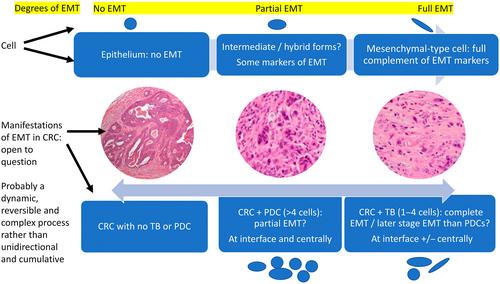下载PDF
{"title":"21世纪结直肠癌的萌芽、集群和转变:革命还是再造?†","authors":"Roger M Feakins, Maurice B Loughrey, Andrew Silver","doi":"10.1002/path.6173","DOIUrl":null,"url":null,"abstract":"<p>Tumour budding (TB) describes single or small groups of neoplastic cells that lack continuity with an advancing tumour front. Poorly differentiated clusters (PDCs) are larger and qualitatively different. TB grade and PDCs may predict a worse outcome in colorectal carcinoma and other cancers and fall into the category of ‘invasive front prognostic markers’ that also includes intratumoural stroma type. Epithelial–mesenchymal transition (EMT) allows the adoption by epithelial cells of mesenchymal characteristics such as dyscohesion, migration, and stromal invasion. TB and PDCs harbor alterations in EMT-related proteins and RNAs and may be morphological manifestations of EMT. However, persistence of epithelioid features and absence of a full complement of typical alterations in TB and PDCs may indicate ‘partial EMT’, i.e. an intermediate/hybrid state. Recently, Pavlič <i>et al</i> asserted that TB and PDCs in colorectal cancer represent different manifestations of partial EMT and, perhaps controversially, that TB is closer than PDCs to complete transition. In clinical practice, low inter-observer agreement for invasive front prognostic markers is a potential problem. The UK colorectal cancer pathology dataset advises assessment of TB and recommends the use of an international consensus system, but time will tell if we are adopting reliable prognostic markers or reinventing the wheel. Additional studies of TB, PDCs, and EMT will presumably allow greater insight into their role in tumour development and progression. © 2023 The Authors. <i>The Journal of Pathology</i> published by John Wiley & Sons Ltd on behalf of The Pathological Society of Great Britain and Ireland.</p>","PeriodicalId":232,"journal":{"name":"The Journal of Pathology","volume":"261 2","pages":"121-124"},"PeriodicalIF":5.6000,"publicationDate":"2023-08-11","publicationTypes":"Journal Article","fieldsOfStudy":null,"isOpenAccess":false,"openAccessPdf":"https://onlinelibrary.wiley.com/doi/epdf/10.1002/path.6173","citationCount":"0","resultStr":"{\"title\":\"Buds, clusters, and transitions in 21st century colorectal carcinoma: revolution or reinvention?†\",\"authors\":\"Roger M Feakins, Maurice B Loughrey, Andrew Silver\",\"doi\":\"10.1002/path.6173\",\"DOIUrl\":null,\"url\":null,\"abstract\":\"<p>Tumour budding (TB) describes single or small groups of neoplastic cells that lack continuity with an advancing tumour front. Poorly differentiated clusters (PDCs) are larger and qualitatively different. TB grade and PDCs may predict a worse outcome in colorectal carcinoma and other cancers and fall into the category of ‘invasive front prognostic markers’ that also includes intratumoural stroma type. Epithelial–mesenchymal transition (EMT) allows the adoption by epithelial cells of mesenchymal characteristics such as dyscohesion, migration, and stromal invasion. TB and PDCs harbor alterations in EMT-related proteins and RNAs and may be morphological manifestations of EMT. However, persistence of epithelioid features and absence of a full complement of typical alterations in TB and PDCs may indicate ‘partial EMT’, i.e. an intermediate/hybrid state. Recently, Pavlič <i>et al</i> asserted that TB and PDCs in colorectal cancer represent different manifestations of partial EMT and, perhaps controversially, that TB is closer than PDCs to complete transition. In clinical practice, low inter-observer agreement for invasive front prognostic markers is a potential problem. The UK colorectal cancer pathology dataset advises assessment of TB and recommends the use of an international consensus system, but time will tell if we are adopting reliable prognostic markers or reinventing the wheel. Additional studies of TB, PDCs, and EMT will presumably allow greater insight into their role in tumour development and progression. © 2023 The Authors. <i>The Journal of Pathology</i> published by John Wiley & Sons Ltd on behalf of The Pathological Society of Great Britain and Ireland.</p>\",\"PeriodicalId\":232,\"journal\":{\"name\":\"The Journal of Pathology\",\"volume\":\"261 2\",\"pages\":\"121-124\"},\"PeriodicalIF\":5.6000,\"publicationDate\":\"2023-08-11\",\"publicationTypes\":\"Journal Article\",\"fieldsOfStudy\":null,\"isOpenAccess\":false,\"openAccessPdf\":\"https://onlinelibrary.wiley.com/doi/epdf/10.1002/path.6173\",\"citationCount\":\"0\",\"resultStr\":null,\"platform\":\"Semanticscholar\",\"paperid\":null,\"PeriodicalName\":\"The Journal of Pathology\",\"FirstCategoryId\":\"3\",\"ListUrlMain\":\"https://onlinelibrary.wiley.com/doi/10.1002/path.6173\",\"RegionNum\":2,\"RegionCategory\":\"医学\",\"ArticlePicture\":[],\"TitleCN\":null,\"AbstractTextCN\":null,\"PMCID\":null,\"EPubDate\":\"\",\"PubModel\":\"\",\"JCR\":\"Q1\",\"JCRName\":\"ONCOLOGY\",\"Score\":null,\"Total\":0}","platform":"Semanticscholar","paperid":null,"PeriodicalName":"The Journal of Pathology","FirstCategoryId":"3","ListUrlMain":"https://onlinelibrary.wiley.com/doi/10.1002/path.6173","RegionNum":2,"RegionCategory":"医学","ArticlePicture":[],"TitleCN":null,"AbstractTextCN":null,"PMCID":null,"EPubDate":"","PubModel":"","JCR":"Q1","JCRName":"ONCOLOGY","Score":null,"Total":0}
引用次数: 0
引用
批量引用


 求助内容:
求助内容: 应助结果提醒方式:
应助结果提醒方式:


